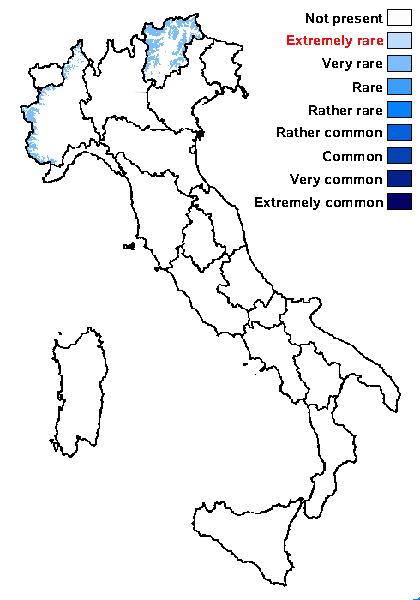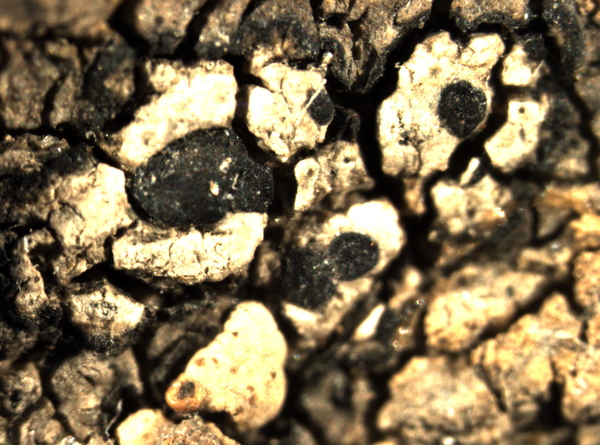Lecidea verruca Poelt
Mitt. bot. Staatss. München, 4: 187, 1961.
Synonyms:
Distribution: N - TAA, Piem (Hafellner 2008).
Description: Thallus crustose, episubstratic, whitish, forming 1-6(-10) mm wide, rounded to irregular, flat to slightly convex islands on the thalli of other crustose lichens (Aspicilia-species). Cortex with an epinecral layer; medulla, white, I+ deep blue at least in lower part. Apothecia lecideine/biatorine, black, semi-immersed to appressed, rounded to angular in outline, 0.3-0.8(-1.2) mm across, with a black, flat to slightly convex, epruinose or weakly pruinose, not umbonate disc and a thin, often soon excluded proper margin. Proper exciple poorly developed, with a brownish rim, colourless within, 25-40 µm wide in upper part; epithecium olive-brown to green-black; hymenium colourless, 40-60(-75) µm high, I+ blue; paraphyses coherent, simple or rarely branched in upper part, usually not anastomosing, the apical cells 4-5 µm wide; hypothecium colourless to very pale brown, I+ blue. Asci 8-spored, narrowly clavate, thick-walled, with a K/I+ pale blue tholus and a strongly amyloid, thin apical cushion, surrounded by a I+ blue outer layer, Lecidea-type. Ascospores 1-celled, hyaline, ellipsoid to broadly ellipsoid, 8.5-12(-14) x 5-6(-7) µm, not halonate, rather thick-walled. Pycnidia developed on sterile, smaller (1-3 mm wide) thalli, semi-immersed, black, the ostiolar region at first punctiform, then expanded. Conidia bacilliform, straight to slightly curved, (7-)10-12(-14) x 1-1.5(-2) µm. Photobiont chlorococcoid. Spot tests: thallus K-, C-, KC-, P-. Chemistry: confluentic acid syndrome.Note: an arctic-alpine, bipolar silicicolous species with a peculiar ecology (Hertel 2006), always growing on species of Aspicilia near or above treeline; related to L. tessellata.
Growth form: Crustose
Substrata: rocks
Photobiont: green algae other than Trentepohlia
Reproductive strategy: mainly sexual
paras Aspicilia spp.
Commonnes-rarity: (info)
Alpine belt: very rare
Subalpine belt: very rare
Oromediterranean belt: absent
Montane belt: absent
Submediterranean belt: absent
Padanian area: absent
Humid submediterranean belt: absent
Humid mediterranean belt: absent
Dry mediterranean belt: absent

Predictive model
Growth form: Crustose
Substrata: rocks
Photobiont: green algae other than Trentepohlia
Reproductive strategy: mainly sexual
paras Aspicilia spp.
Commonnes-rarity: (info)
Alpine belt: very rare
Subalpine belt: very rare
Oromediterranean belt: absent
Montane belt: absent
Submediterranean belt: absent
Padanian area: absent
Humid submediterranean belt: absent
Humid mediterranean belt: absent
Dry mediterranean belt: absent

Predictive model
 INDEX FUNGORUM
INDEX FUNGORUM
 GBIF
GBIF
 DOLICHENS
DOLICHENS





